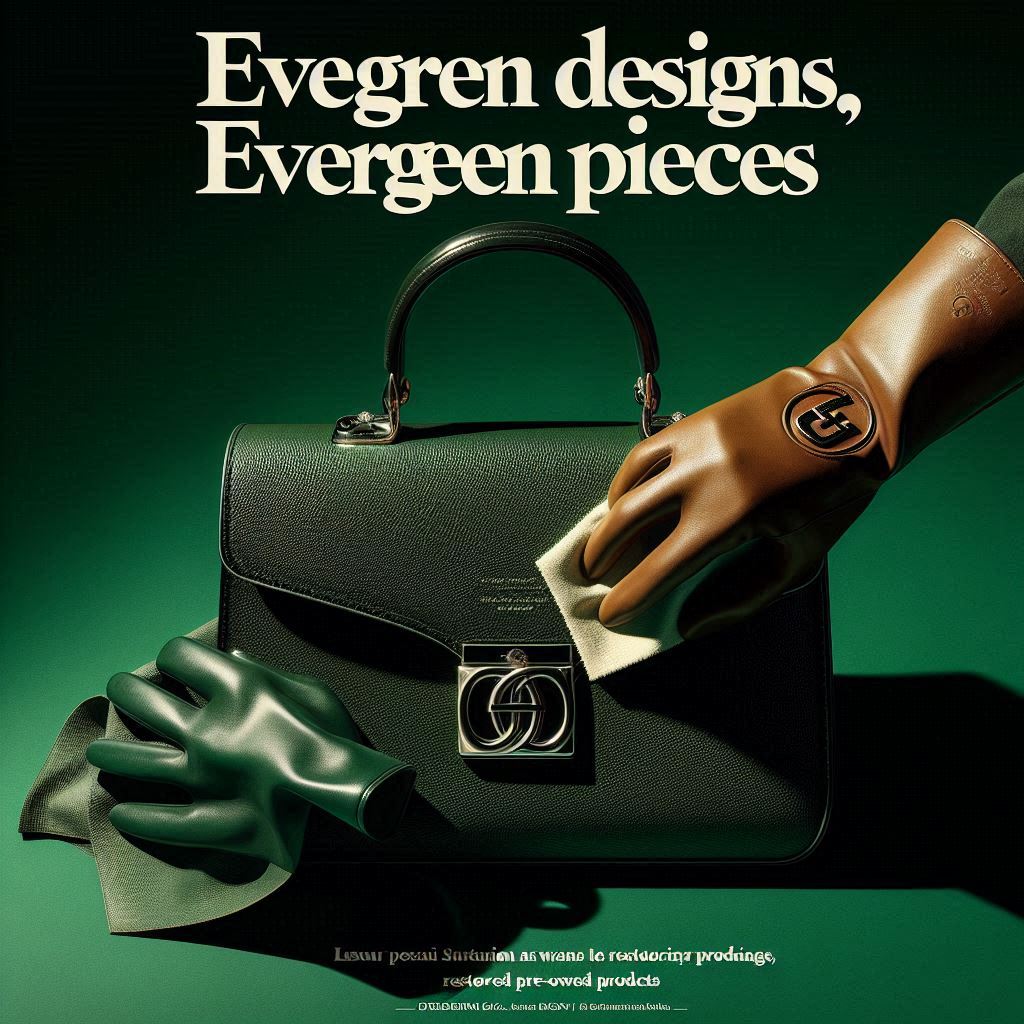Project related to full-time master’s degree Fashion and Luxury Business, Major of the Master in International Management, Amsterdam and Milan
My Prompt
TEXT PROMPT:
1. Write a long-form article presenting an initiative named “Sustainable Exclusivity: Upholding Scarcity in the Resale Era.”. The main objective of the initiative is to conciliate the sustainable practice of reselling vintage (designer) pieces with the need for luxury to manage the challenge of luxury democratization. The idea is to incentivize luxury houses to not only manufacture scarcity in the market for their products but to retain exclusivity by taking charge of their own resale market. This transition from resale to recommerce is done by: 1. launching upcycled collections each season, aligned to the house vision for the season but sourced from pre-owned items; 2. owning their own archive platform for restored but unchanged archive pieces. This creates availability for these pieces through regular retail channels and not reselling platforms, which allows houses to retain control over their distribution. Trade-in estimates and sourcing could be done either by a second-party or by the house itself, with the possibility for the seller or consumer to obtain credit for the new collections. Please elaborate on the operational steps houses would need to implement for this transition to take place. A more circular mode of production would allow for brand repositioning in terms of sustainability while satisfying the craving for distinctive pieces, as consumers manifest a growing desire for uniqueness. Make sure to highlight the social impact of the initiative, acknowledging the fact that it may seem tone-deaf at first to fight luxury democratization while advocating for sustainability (which, in its broader sense, means advocating for a more equal society), and explain why it ultimately is not.
2. Make it longer and more detailed.VISUALS:
1. create an editorial poster for a luxury fashion campaign about restored pre-owned products. emerald green background, highlighting both the sustainability and the luxury aspect, a big designer nappa handbag in the center with a big logo, projecting a shadow against the green background. show an arm, with a leather designer glove with the same big logo, waxing the bag with a cloth. Text: “Evergreen designs, Evergreen Pieces”
2. create an editorial poster (scanned magazine, vintage effect) for a luxury fashion campaign about restored pre-owned products. emerald green background, highlighting both the sustainability and the luxury aspect, a big designer nappa handbag in the center with a big logo, projecting a shadow against the green background. show an arm, with a leather designer glove with the same big logo, waxing the bag with a cloth. Text: “Evergreen designs, Evergreen Pieces”
3. create an editorial poster (scanned magazine, vintage effect) for a luxury fashion campaign about restored pre-owned products. emerald green background, highlighting both the sustainability and the luxury aspect, a big designer handbag in the center with a big logo is pulled from the magazine, projecting a shadow against the green backdrop. show an arm, with a leather designer glove with the same logo, waxing the bag with a cloth. Text: “Evergreen designs, Evergreen Pieces”
Ai Tools: Text: Claude AI, Visuals: Microsoft Copilot Designer
Sustainable Exclusivity: Luxury’s Reinvention for a Circular Future
In the world of haute couture, scarcity has long been the ultimate arbiter of exclusivity. Yet as the $51 billion luxury resale market fuels rampant product democratization, the very essence of what defines true luxury is under siege. Enter “sustainable exclusivity” – a pioneering initiative that charts luxury’s reinvention for a circular age.
At its core, sustainable exclusivity seeks to reconcile luxury’s existential quandary: how to uphold the tantalizing allure of scarcity and distinction while catalyzing a sustainable product cycle? The answer lies in an innovative re-commerce model where luxury houses reclaim control over their entire life cycles – taking stewardship over their most precious asset, heritage.
Upcycled Capsule Collections
Each season, brands will unveil special limited-edition capsule collections crafted from repurposed archival pieces and defective inventory. However, these are no mere restoration projects. Through a surgical process of deconstruction and renewal, luxury’s most iconic design codes are iteratively reborn for a new era.
An emblematic Hermès silk scarf pattern is disassembled and masterfully refashioned into a structured handbag silhouette. A vintage Chanel tweed jacket is deconstructed, only to re-emerge as a contemporary peplum blouse interpretation. Envisioned through the latest creative optics, heritage pieces transcend mere refurbishment to become vanguards of the house’s visionary spirit.

Archive Retail Hubs
Complementing these avant-garde upcycled pieces will be immersive retail hubs devoted to unmolested archival pieces in pristine original condition. However, unlike third-party resellers, these salon-style boutiques will exist as seamless white-label extensions under each brand’s corporate umbrella.
Picture a digital Chanel gallery where one can acquire a prize 1990s double-flap bag – hand-sourced from collectors, authenticated by experts, and enshrined with compelling heritage provenance. Envision Rolex unveiling a salon where enthusiasts can procure a heritage Paul Newman Daytona straight from the source, certified authentic and refurbished to uncompromising standards.
Through this vertically integrated control over sourcing, pricing, authentication and merchandising of re-issued pieces, brands regain agency over their exclusivity. Supply can be precisely regulated against demand not just for new pieces, but heritage ones as well – preserving desirability through calibrated scarcity. For collectors, the brand’s official certification lends these pieces a powerful aura of legitimacy and status unmatched by even the most premium reseller.
Trade-In Incentives
To facilitate this circularity, many brands will institute lucrative trade-in programs where past-season pieces can be relinquished in exchange for generous credits toward new products or white-glove services. After rigorous authentication and assessment (whether in-house or via vetted partners), owners can responsibly return pieces into the brand’s supply chain while being rewarded for their loyalty.
Far from one-way disposability, sustainable exclusivity cultivates a virtuous and perpetual product loop while reinforcing the privileges of initiation into these luxury universes.
Implementing the Transition
Of course, pivoting to sustainable exclusivity requires transformational investments. Brands must develop robust valuation processes to accurately determine piece residual worth based on condition, age, materials and more. In-house teams of experts – from couriers to authentication gemologists – may need to be embedded, or partnerships cultivated with specialist third-party appraisers.
Central to the model are upcycling ateliers – specialized facilities staffed by master artisans and designers singularly devoted to the deconstructive reinvention of archival pieces. From intensive materials science to bonding technology, immense R&D capabilities must be marshaled to preserve heritage DNA while surgically graftingh contemporary relevance.
Curated archive facilities akin to museum-level collections must be constructed to properly catalog, restore and merchandise pieces with immersive heritage storytelling. Front-facing retail temples – physical and digital – must radiate the gravitas to enshrine these pieces as rarefied collector’s artifacts of distinction.
It’s a revolutionary operational endeavor requiring specialized capabilities across authentication, upcycling, restoration, archival management and retail transcendence. But it’s one which allows heritage houses to quite literally curate their own circularity while retaining authoritative stewardship over their exclusive auras.
Addressing the Social Impact
At first glance, an initiative centered on exclusivity may seem paradoxical to sustainability’s ethos of equitability and accessibility. How can battling the democratization of luxury products harmonize with ideals of a more conscientious, egalitarian society?
The key lies in recognizing that sustainable exclusivity doesn’t seek to inhibit participation, but rather elevate the consciousness surrounding luxury consumption itself.
By establishing circular reCommerce models and providing compelling incentives for product reuse, it actively reduces the net material footprint of luxury. Consumers are empowered as conscious agents steering haute couture’s sustainability journey – making values-driven choices through trade-ins rather than passively indulging.
Moreover, the initiative redefines luxury as a celebration of craft mastery, heritage and authenticity over mere acquisitive signaling. As Pauline Chardin wrote, “True luxury has an ethical soul rooted in honoring art, not just owning it.” Scarcity and high pricing become symbols of those intangible values – durability, craftsmanship, storied provenance – rather than shallow material displays of status.
In venerating the “antiquarians of fashion” preserving these rarefied traditions, sustainable exclusivity could well fortify artisan vocations while reviving the perceived cultural value of their output. It uplifts the luxury realm from disposable indulgence towards enrichment through conscious appreciation and enduring stewardship.
Underpinning this transformation is a vision where luxury’s net societal impact is elevated. Brands can burnish reputations through mindful, circular business practices. Artisans sustain honorable livelihoods as respected culture-bearers. And consumers derive enrichment through connoisseurship rather than vapid ownership and discard.
The greatest social contribution is positioning luxury’s evolution from excess towards essence – from rampant materialism towards more holistic gratification. For luxury to maintain its prestige, a degree of scarcity must be preserved and access limited only to those who truly appreciate its values. Unchecked democratization won’t uplift society – just render heritage houses homogenized purveyors of soulless, mass affluent accessories.
Through sustainable exclusivity’s integrated model, a rising tide of conscious connoisseurship can uplift all participants. It’s an aspiration as sustainably regenerative as it is tantalizingly rarefied – the embodiment of true luxury’s most cherished ideals for generations to come.



